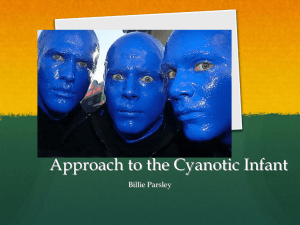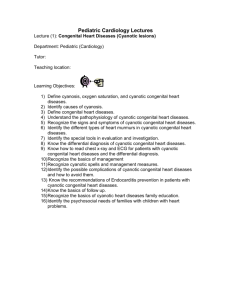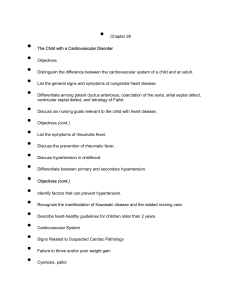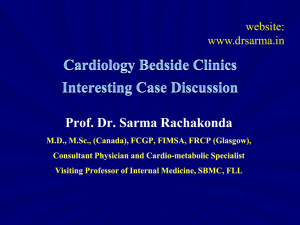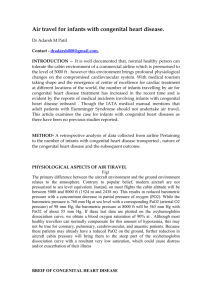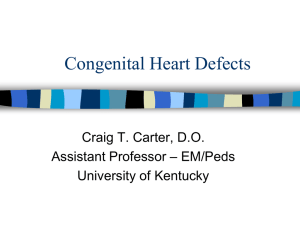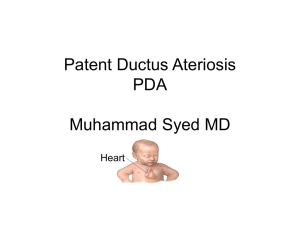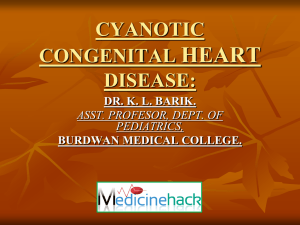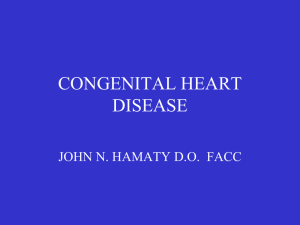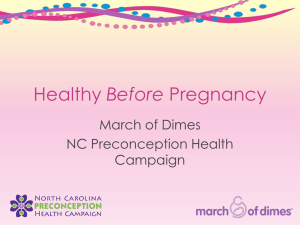from birth defects - Michigan Society for Respiratory Care
advertisement
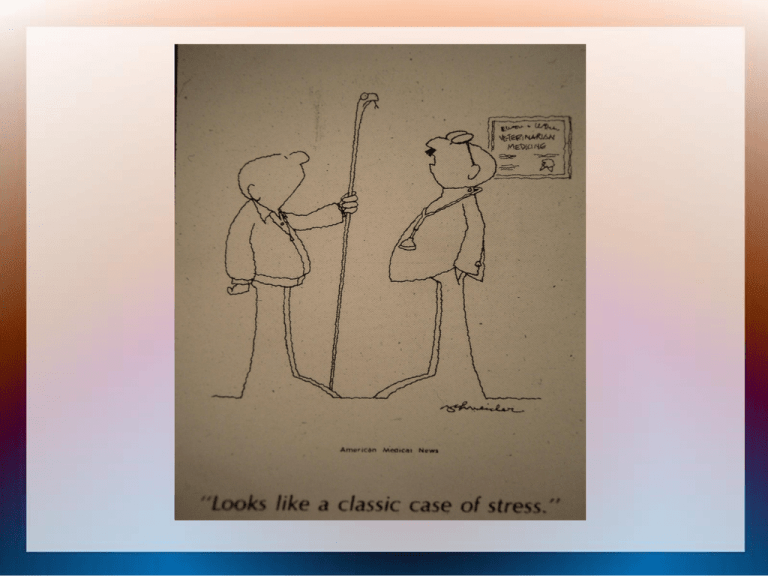
Congenital Heart Disease Seth Malin, MD Bronson Methodist Hospital MSU KCMS, College of Human Medicine What is congenital heart disease? Congenital heart defects are structural problems with the heart present at birth. They result when a mishap occurs during heart development soon after conception and often before the mother is aware that she is pregnant. Defects range in severity from simple problems, such as "holes" between chambers of the heart, or “extra” vessels, to very severe malformations, such as complete absence of one or more chambers or valves. Many of these defects are simple conditions that are easily fixed or need no treatment. A small number of babies are born with complex congenital heart defects that require special medical care soon after birth. Over the past few decades, the diagnosis and treatment of these complex defects has greatly improved. As a result, almost all children who have complex heart defects survive to adulthood and can live active, productive lives. National Heart Lung and Blood Institute, 2009 How serious is the problem? Congenital heart defects are the most common birth defect and are the number one cause of death from birth defects during the first year of life. Nearly twice as many children die from congenital heart disease in the United States each year as die from all forms of childhood cancers combined. In 2005, 192,000 life-years were lost before age 55 in the United States due to congenital heart disease. In 2004, hospital costs totaled $2.6 billion. American Heart Association, 2009 Where to start? Congenital heart disease occurs in from 2.5 to 8.8 babies per 1000 live born infants. The low incidence is for severe disease only; the higher is for all diagnoses including mild problems. There is probably regional variation; some mild disease is asymptomatic and is only diagnosed later in life. Severe disease almost always presents early. Where to start? In a policy statement in 2009, the AAP and the AHA estimated that the incidence of cyanotic congenital heart disease in newborn infants to be 9 per 1000 live births. The American Heart Association estimates that about 35000 babies with CHD are born each year Where to start? Michigan has a birth rate of about 125000 births per year. If the incidence of CHD is 9 per 1000, then about 1125 babies with heart disease will be born in Michigan each year. The NIH estimates that about 1000000 people are living with congenital heart disease (2009). How do we know? Prenatal ultrasound helps. Pediatric cardiologists can perform fetal echocardiograms. About 96 percent sensitivity for accurate diagnosis if the physician and tech are skilled and experienced. How do we know? Screening of “normal” newborn infants is somewhat controversial. We obviously can't perform an ECHO on all newborns. Use of postnatal pulse oximetry may be useful but is still controversial (Pediatric Cardiology 2002;23:403-409). Only 4 infants were identified in 18 months using oximetry (sat <92) while 32 were identified in 6 months using other means. Let's talk about signs and symptoms Symptom: 1. any phenomenon or circumstance accompanying something and serving as evidence of it. 2.a sign or indication of something. 3.Pathology. a phenomenon that arises from and accompanies a particular disease or disorder and serves as an indication of it. Sign: 4.Medicine/Medical: the objective indications of a disease. So most of my patients have signs but not symptoms except as reported by the parents. So....what are the signs that a patient may have a congenital heart disease? How do we know? Most infants with cardiac disease have one of four presentations: Murmur Cyanosis (with or without a murmur) Progressive symptoms of heart failure Catastrophic heart failure and shock PedsReview 2007; 28(4):123-131 Murmur Sound produced by turbulent blood flow through the heart or valves May be due to increased cardiac output in conditions such as anemia May be “innocent” and insignificant May be due to abnormal valves (eg, aortic stenosis) May be due to a hole (eg, VSD) May be due to regurgitant flow (backflow through a valve) Murmurs Abnormal blood of low velocity or low volume may not cause a murmur. High-pitch or harsh murmurs, or those associated with a thrill are pathologic. A thrill is a palpable murmur; the thrill is caused by highly turbulent blood flow directed towards the chest wall. Cyanosis From the Greek for BLUE The term cyanide comes from the iron compound (iron ferrocyanide) found in Prussian blue dye Human poisoning causes the skin to become pink due to cyanohemoglobin (according to wikipedia) and causes death by blocking cytochrome oxidase and blocking oxidative metabolism. Cyanosis Cyanosis is a blue color of the skin and mucous membranes due the presence of deoxygenated hemoglobin in the capillaries near the skin surface. Deoxygenated Hemoglobin Deoxyhemoglobin is blue. When the concentration of deoxyHb exceeds about 5mg/dl the blood and hence the tissues will have a bluish cast. Where the capillaries are near the skin, and not obscured by hair or pigment, the skin and mucous membranes will be bluish. Cyanosis In the delivery room, babies are supposed to start out blue and become pink. The first part to pink-up is the head, and the easiest place to see the pink color is in the lips and tongue. Making babies pink too fast may not be good; the NRP suggests using 40% oxygen for resuscitation to avoid oxygen toxicity Remember that Oxygen above RA is a drug! Cyanosis Mixing of oxygenated and deoygenated blood (arterial and venous) causes cyanosis in CHD. Failure of oxygenated blood to get to the systemic circulation will also cause cyanosis. Cyanotic heart disease Remember the “Five Ts” Transposition Tetralogy of Fallot Tricuspid atresia Total anomalous pulmonary venous return (TAPVR) Truncus arteriosus These are the “classic” cyanotic heart diseases. Cyanotic heart disease The fiveTs don't necessarily present the same, and may not present with cyanosis. Only transposition of the great arteries is associated with severe cyanosis in the first hours of life. The cyanosis occurs because the oxygenated pulmonary venous blood can't reach the systemic circulation. Cyanotic heart disease In the other lesions, the degree of admixture of the “arterial” and “venous” blood determines the degree of cyanosis. If pulmonary blood is increased, patients with these “admixture” lesions can have room air saturations of 90% or more. Cyanotic CHD Defects preventing right ventricular outflow can present with earl cyanosis Pulmonary atresia Ebstein's anomaly (apical displacement of the tricuspid valve into the RV decreases the amount of blood that the RV can pump and also causes a shunt across the atrial septum). Severe Ebstein's can present in the DR or soon after. The PDA Two topics: the PDA in the small premature infant and the PDA in the infant with cyanotic heart disease. We will discuss the premie situation later... The PDA The PDA acts to shunt blood to and from the pulmonary and the systemic circulations. If the ductal flow is high, the admixture can be enough to minimize cyanosis. Conversely when the ductus closes like it is supposed to, the babies will begin to have difficulties. Heart Failure Due to excessive pulmonary blood flow or inadequate systemic blood flow. Large VSDs, endocardial cushion defects (atrioventricular septal defects), or large PDA with normal heart are associated with signs of heart failure after the pulmonary vascular resistance drops, as it is supposed to do in the days after birth. Heart Failure Tachypnea Diaphoresis, especially of the forehead Poor feeding Failure to thrive Gallop rhythm on auscultation Hepatomegaly Presenting as shock Infants with inadequate development of the left ventricle will present with catastrophic heart failure and shock as the ductus arteriosus closes. The closure of the ductus results in decreased/ing systemic blood flow. The right heart is supplying the entire systemic blood flow (HLH) or the systemic flow to the lower body (coarctation, interrupted aortic arch) Heart Failure In the nursery, the only sign of these lesions may be: Single and loud S1 , Increased precordial activity on palpation, Mildly abnormal postductal oximetry Decreased femoral pulses usually not present until the ductus closes After the nursery and sometimes in it! Sepsis-like picture with poor color and perfusion Tachypnea Mottling Gray or cyanotic pallor Decreased central and peripheral pulses (This where assessment comes in again....and sometimes it helps if someone says “could this be cyanotic heart disease?”) The premie ductus The ductus in the premie is supposed to close. When it doesn't, the result is increased pulmonary blood that we think causes increased oxygen needs, increased rerspiratory support needs etc. If premie has a PDA and we can't wean O2, vent, or CPAP we blame the ductus and treat the duct with Indomethacin or Ibuprofen The premie ductus Both medications have side effects and require that the baby be NPO for the duration of treatment and a bit more. Gut perforation? Renal failure? The Ductus in CCHD Keeping the ductus open will allow the admixture of blood and will maintain systemic and/or pulmonary blood flow An intravascular infusion of Prostaglandin E1 (alprostadil)will keep the ductus open Bonus points: where was alprostadil developed? Right down the street at Upjohn! Assessment Look for other findings on exam that may suggest an associated diagnosis For example, trisomy 21 babies have an increased incidence of AV canal defects and need an Echo to rule out that diagnosis. And now for some pictures, because they are easier to understand. Cincinnati Children's Hospital (U of Cincinnati) and CS Mott Children's Hospital (U of M) Both have great websites with nice pictures and descriptions of the surgical repair options. Normal Heart Fetal Circulation Persistent Pulmonary Hypertension Transposition TGA Repair Tetralogy of Fallot Tricuspid Atresia Tricuspid Atresia TAPVR Total Anomalous Pulmonary Venous Return Truncus Arteriosus Hypoplastic Left heart HLH Repair Atrioventricular Septal Defect AV Canal Atrioventricular Septal Defect AV Canal Valves AV Canal Repair Ebstein's Malformation Coarctation of the Aorta Ventricular Septal Defect Thanks for your attention Are there any questions? References Any neonatal text Hany A. Respiratory Disorders in the Newborn: Identification and Diagnosis. Peds In Review,2004, 25(6):201-208 Silberbach M, Hannon D: Prsentation of Congenital Heart Disease in the Infant and Young Infant. Peds in Review, 2007,28(4):123-131 References AHA website Cincinnati Children's Hospital website U of M , Mott Children's Hospital website NIH website Texas Children’s Hospital/Texas Heart Institute website


